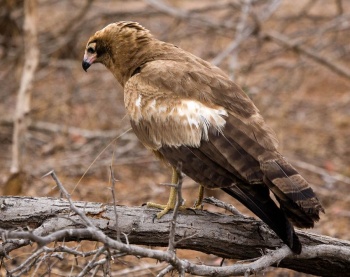(Flight picture of nominate adult. References updated) |
(Alternative name added. References updated. Video link removed as no longer available) |
||
| Line 1: | Line 1: | ||
[[Image:African_Harrier_Hawk.jpg|thumb|550px|right|Adult<br />Photo by {{user|Steve+G|Steve G}}<br />Near Lake Zwai, [[Ethiopia]], March 2005]] | [[Image:African_Harrier_Hawk.jpg|thumb|550px|right|Adult<br />Photo by {{user|Steve+G|Steve G}}<br />Near Lake Zwai, [[Ethiopia]], March 2005]] | ||
| + | '''Alternative name: Gymnogene''' | ||
;[[:Category:Polyboroides|Polyboroides]] typus | ;[[:Category:Polyboroides|Polyboroides]] typus | ||
==Identification== | ==Identification== | ||
| Line 38: | Line 39: | ||
</gallery> | </gallery> | ||
==References== | ==References== | ||
| − | #{{Ref- | + | #{{Ref-Clements6thAug21}}#Kemp, A. C. and J. S. Marks (2020). African Harrier-Hawk (Polyboroides typus), version 1.0. In Birds of the World (J. del Hoyo, A. Elliott, J. Sargatal, D. A. Christie, and E. de Juana, Editors). Cornell Lab of Ornithology, Ithaca, NY, USA. https://doi.org/10.2173/bow.afhhaw1.01 |
{{ref}} | {{ref}} | ||
==External Links== | ==External Links== | ||
{{GSearch|Polyboroides+typus}} | {{GSearch|Polyboroides+typus}} | ||
| − | + | ||
| − | |||
[[Category:Birds]] [[Category:Polyboroides]] [[Category:Videos]] | [[Category:Birds]] [[Category:Polyboroides]] [[Category:Videos]] | ||
Revision as of 10:14, 11 October 2021
Alternative name: Gymnogene
- Polyboroides typus
Identification
51–68 cm (20-26¾ in)
As with other birds of prey, the bill is short with a sharp, hooked tip to the upper mandible. The bill is black, and the cere and facial skin are yellow (red when displaying). The feet and legs are yellow.
The upperparts, head and neck are grey. There are large black spots on the wing coverts. The face is bright yellow, and the belly is finely barred with black and white. The tail is longish and is white, with a single white bar across the middle and a narrow white tip. The head is quite small compared to other raptors, and in flight the wings are broad and rounded.
Distribution
Sub-Saharan Africa: widespread from Senegal to central Ethiopia and south to the Cape (South Africa).
Absent only from the most arid areas of the Horn of Africa and the south-west.
Resident, possibly nomadic in some areas and fairly common in much of its range.
Taxonomy
Subspecies
Two[1] to three subspecies are recognised:
- P. t. pectoralis: smaller, darker and more heavily barred than the nominate subspecies
- Senegambia to western Sudan, Niger and Democratic Republic of the Congo
- P. t. typus:
- Eastern Sudan to Eritrea, Angola and South Africa
Subspecies prigoginei (smaller and darker birds from western DRC) is not generally recognised.
Habitat
It is found in closed and open savanna woodlands, forests, near wooded kloofs or stands of alien trees. It is usually solitary and spends much time perched in tall trees and is usually seen flying over or near forests or well-wooded areas.
Behaviour
Diet
They are specially adapted for extracting food from holes and crevices in trees. The tarsal joint "knee" can bend backwards, sideways or forwards - allowing the bird to use its long legs/feet to get into tree cavities where it preys on bats, nestlings, reptiles and amphibians. It also eats insects and birds eggs.
Breeding
They breed from June to November. The nest is a stick platform, about 75cm in diameter which is placed in the canopy of a tree or on a bush on a cliff face or in a small rock niche. The nest is lined with green sprigs.
Vocalisation
The call is a plaintive whistled su-eeee-oo or a high pitched wheep-wheep near the nest.
Gallery
Click on photo for larger image
Sub-adult
Photo by GarethH
Kruger National Park, South Africa, February 2006
References
- Clements, J. F., T. S. Schulenberg, M. J. Iliff, S. M. Billerman, T. A. Fredericks, J. A. Gerbracht, D. Lepage, B. L. Sullivan, and C. L. Wood. 2021. The eBird/Clements checklist of Birds of the World: v2021. Downloaded from https://www.birds.cornell.edu/clementschecklist/download/
- Kemp, A. C. and J. S. Marks (2020). African Harrier-Hawk (Polyboroides typus), version 1.0. In Birds of the World (J. del Hoyo, A. Elliott, J. Sargatal, D. A. Christie, and E. de Juana, Editors). Cornell Lab of Ornithology, Ithaca, NY, USA. https://doi.org/10.2173/bow.afhhaw1.01
Recommended Citation
- BirdForum Opus contributors. (2024) African Harrier-Hawk. In: BirdForum, the forum for wild birds and birding. Retrieved 18 April 2024 from https://www.birdforum.net/opus/African_Harrier-Hawk








